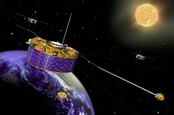This article is more than 1 year old
Out on a tangent: Almost two decades into its 5-year mission, INTEGRAL still delivers the gamma ray goods
From gravitational discoveries to controlled 2029 re-entry, they sure knew how to build 'em
Space Extenders In this penultimate edition of The Register's series looking at how ESA keeps its fleet of spacecraft ticking over, years or even decades after their expiry dates, we turn to INTEGRAL.
Launched on 17 October 2002, atop a Proton from the Baikonur Cosmodrome, ESA's International Gamma-Ray Astrophysics Laboratory (INTEGRAL) is a mission aimed at helping crack some of the biggest mysteries in astronomy.
INTEGRAL got the nod from ESA's Science Programme Committee back in 1993 and is the second medium-sized mission of the Horizon 2000 programme. NASA and Russia cooperated with ESA on the mission, with the former helping in the development of the onboard instruments and offering ground station time, and the latter handing over a free ride on a Proton in return for observing time.
Gamma rays are intercepted by the Earth's atmosphere, meaning the best place to study them is from space. A number of spacecraft have been launched to study them over the years, including Europe's COS-B in 1975, which lasted until 1982 (considerably longer than expected), the Russian Granat, which performed nine years of science after a 1989 launch, and NASA's Compton Gamma Ray Observatory (CGRO), which was released from Space Shuttle Atlantis during STS-37 in 1991 and operated until a controlled de-orbit at the end of 1999.
The satellite itself stands five metres in height and weighs four tonnes. Its service module, containing power generation and conditioning, control and communications, is a rebuild of the one used by XMM-Newton, which goes some way to explaining INTEGRAL's extraordinary longevity. Launched with an expectation that the satellite would have an initial two-year mission, with an extension to five years, INTEGRAL will be celebrating the 18th anniversary of its launch this year and plans are afoot to keep it ticking over into 2029.
The Register spoke to INTEGRAL's spacecraft operations manager Richard Southworth and project scientist Dr Erik Kuulkers about the challenges and benefits of operating the long-lived spacecraft.
Functioning in the modern world
While INTEGRAL has outperformed all expectations, the environment it operates in is, as Southworth puts it, "not nice, and it's actually getting worse." The highly elliptical three-day orbit of the satellite gave it an apogee of 153,000km, which means it spends a great deal of its time outside the Earth's radiation belts.
However, Southworth observed: "We have quite the orbital variation. And one of the things that has changed dramatically is the perigee altitude."
ESA currently lists the perigee at 9,000km, and every time INTEGRAL passes through those radiation belts (known as the Van Allen belts) it is bombarded by heavy trapped proton particles. The most obvious impact has been a gradual degradation of the solar arrays over the years.
"The power output is going down," explained Southworth. "It's not yet critical, but will become difficult to manage. So at the moment we're making plans to deal with these power budget issues. Related to that we've noticed other electronic components are being affected."
While the team has seen very few bit flips over the course of the mission, Southworth did note a series of computer crashes in 2019 which were eventually attributed to an interfacing unit, the responses of which were slowing down and causing time-outs (and necessitating restarts).
The team dealt with the problem by reprogramming the telemetry acquisition in an attempt to spread the load for the onboard computer to accommodate the longer lead times.
"It was always the same interrupt in the software cycle," he told us, "and this was timing out. Eventually we saw that this coincided with the acquisition and building of three big complex telemetry packets.
"We just spread out the acquisition of this data over several interrupts and substituted some of this complex data with a more simple data packet from the instruments.
"So far, it seems to have worked. We have not had a reoccurrence since August last year."
While pretty much all the instruments have been patched at one time or another, the central computer has never had its software changed "and I want to keep it like that," said Southworth.
The most recent instrument patch required the team to develop code to work around a permanent bit failure in a memory page. "It was a fairly simple patch," Southworth explained. While not a dramatic change, "it proved we could do it, compile it, uplink it and activate it."
As well as occasional flips of the transistor switches used to control spacecraft systems such as heaters and power supplies, the changes in orbit require constant replanning from the perspective of ground stations. INTEGRAL has no onboard storage for science and so must be kept in contact with Earth for observations.
Another challenge is something with which all too many IT admins will be familiar – hardware and software obsolescence. The control system for INTEGRAL was developed in the late 1990s on what was then Sun Solaris hardware. Obsolescence has meant porting systems and interfaces (or maintaining those interfaces).
"It is really a big chunk of our work, just making sure that the ground systems we have continue to function in this modern world!"
Starting from scratch
Other than permanent issues, such as the degradation of the solar arrays, the gang has had to deal with many one-off failures over the years. Single Event Upsets (SEUs) present some of the greatest challenges, potentially taking the team days to recover the spacecraft.
One, which occurred in the middle of the last decade, had left INTEGRAL in what Southworth called "absolute Safe Mode."
Everything had been automatically powered down as a result of the SEU: "All the instruments were off, only the basic heaters were on," he recalled.
"Basically, we had to start from scratch. It is like launching. It's like switching on the satellite from pre-launch and going up through all the modes, loading memory, configuring the instruments, configuring the detectors, things like that. And checking that no damage has been done and that we have the configuration correct and so on and so forth."
The event highlighted another issue. Southworth is the sole remaining member of the original team. "The entire team had changed twice since then," he explained. The original procedures had fortunately been very well written but "it was new territory for us. It was an interesting week."
Thanks to its longevity, INTEGRAL has also continued ESA's rich tradition of growing an extra instrument or two. Launched with four instruments (SPI, a spectrometer; IBIS, an imager; JEM-X, the X-ray monitor; and OMC, an optical monitor,) the satellite also features a radiation monitor to assess the background and thereby the sensitivity and performance of the science payload.
While ostensibly there to protect the other instruments, the radiation monitor has proven to be an interesting secondary source for science. Engineers and scientists have used data returned from the device to build a 3D model of the Van Allen belts as well as feeding the information into models to predict how the degradation of the solar arrays will progress.
Dr Erik Kuulkers agreed, describing the modelling as "more of a serendipitous science we're doing," before adding that "the main aim is doing astronomy."
While INTEGRAL has made many discoveries over its nearly two decades of operation – including the observation of a dead star seemingly revived by a nearby red giant, snacking black holes, and one that appeared to be "spitting" jets of plasma – it is the satellite's involvement in the observation of gravitational waves of which Kuulkers is most proud.
The gamma-ray observatory picked a two-second burst of rays (along with NASA's Fermi satellite) which, in itself, was not too unusual (INTEGRAL observes approximately 20 per year), but seconds before the Laser Interferometer Gravitational-wave Observatory (LIGO) experiment, in the USA, recorded the passage of gravitational waves.
Previous to this, gravitational waves had been traced back to black holes colliding. This time, however, by combining the data from INTEGRAL, LIGO, Fermi and Europe's Virgo instrument, scientists were able to show that the event was caused by the merger of neutron stars.
"This is a ground-breaking discovery," Kuulkers said at the time, "revealing for the first time gravitational waves and highly energetic light released by the same cosmic source."
"That signal," he told us, "was seen by the shields around the instruments... If there is a gamma ray burst outside of your normal field of view, you can still detect it as a kind of background by the shields."
The discovery came as INTEGRAL approached the 15th anniversary of its launch, 10 years after the mission was originally expected to end.
While the sheer quantity of data returned by INTEGRAL over the years has been a boon to scientists, the spacecraft is also serving as a calibration source for future missions.
But all good things must come to an end, eventually.


